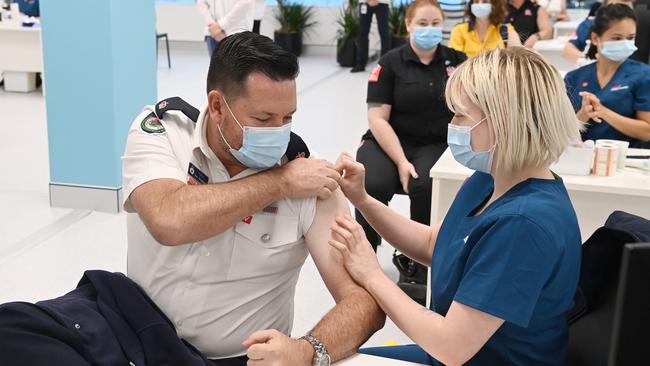Just the shot in the arm to keep us safe and sound
To be sure, the vaccine rollout has long way to go. But Australians’ hesitancy is the bigger threat to herd immunity.

In fact the aim needs to be to get beyond herd immunity, encouraging every Australian to get the jab. The best medical advice tells us that once enough of the population are vaccinated the chances of people getting seriously ill or dying from COVID-19 are low. Lower, perhaps, than is the case with the flu.
Doctors are reluctant to make the flu comparison because of misinformation campaigns during the height of the pandemic last year, before vaccines were available. Denialism about the severity of COVID-19 led to inaccurate claims that it was little different to the flu.
However, once people are vaccinated similarities do exist, comparisons can be made. That was the point Virgin chief executive Jayne Hrdlicka sought to make, albeit clumsily, early in the week.
If Australians are vaccinated in enough numbers we can open our international borders and risk coronavirus ripping through the community. Scary, yes. Counterintuitive, you bet.
But as long as we maintain hygiene practices and use contact tracing techniques learnt during the crisis, few if any Australians should die from the virus. Managing the health impacts becomes the focus, rather than seeking to eradicate the virus as an isolated nation. But only if the country is as near to fully vaccinated as possible. Because those not vaccinated are at as much risk from COVID-19 as at any time during the pandemic — perhaps more so now courtesy of new strains popping up around the globe.
We have seen data out of countries such as Britain, torn apart by coronavirus, showing few if any deaths now that most of the population have been vaccinated. That’s despite continuing high numbers of infections.
In fact, by last month the daily numbers started to reflect more deaths from flu than from COVID-19.
Australia is in the fortunate position of having managed the pandemic better than most. Our isolation and ability to shut ourselves off from the rest of the world have kept infections and death rates low. That has allowed us to take our time with the vaccine rollout, waiting to see the side effects of the various vaccines on the market and to tailor our rollout to put safety first.
But now it’s time to ensure Australians realise how important vaccines are to what comes next. We need a powerful public awareness campaign to promote vaccinations. Breaking through the 30 per cent plus hesitancy in the community to get vaccinated is essential. Clotting problems with the AstraZeneca vaccine certainly haven’t helped.
Yes, we must appeal to people’s collective consciences, but Australians also need to understand that at the individual level they are safer once vaccinated. The chances of complications from vaccines are small compared with the risks of COVID-19 if not vaccinated. Once people understand that they can’t be safe from COVID-19 forever courtesy of a Fortress Australia mentality, that comparison should cut through. This is where a well-tailored public awareness campaign can help.
The Fortress Australia notion may be popular, playing into a long-time cultural appeal in this country for isolation from the rest of the world. Don’t forget, as much as Australia has modernised in recent decades, we are still a country with a long anti-immigration history. The global cut-off can’t and should not last forever. It harms business and, by extension, slows growth and reduces prosperity.
Public policy think tank the McKell Institute has estimated that our isolation from the rest of the world is costing the Australian economy more than $200m a day. These are the economic realities. It isn’t just airlines and the tourism sector that suffer from border closures. We are seeing the effects on universities, with international student numbers drying up, and wider trade and commerce also suffers.
Which is to say nothing of the regressive mindset caused by shutting ourselves off from the global community indefinitely. Our politicians know it is popular, but they must refrain from tapping into it. We have seen premiers exploit the concept of “the other” between Australian citizens by overcooking state border shutdowns. There were some health benefits in doing so early on, but the political games behind such decision-making also were an undeniable factor.
Federal political leaders need to avoid doing the same when it comes to other nations in what might be an election year.
The government has received its fair share of criticism for the slowness of the vaccine rollout. Fair enough. But the latest figures reveal the daily jab numbers hitting 100,000, with 3.5 million Australians vaccinated.
To be sure, there is as long way to go. But it is community hesitancy with getting vaccinated that is the bigger threat to herd immunity, rather than a lack of availability of vaccines.
I have been surprised by how limited information campaigns have been, given that governments of all stripes are usually so quick to roll out unnecessarily politicised ad campaigns when it suits them to do so.
This is one of the few times when a mass campaign has real value.
Finally, on another issue, let me debunk the myth that the amount of debt building up is OK. The absurd unwillingness of the government to get its fiscal house in order isn’t merely hypocritical after the way the Coalition treated Labor in the wake of the global financial crisis — it’s lazy.
Red is the new black as the budget reveals sky-high spending with no effort to get the books in order across the forward estimates. The claim is that we have been ravaged by the pandemic.
But here are the numbers in the government’s own budget (Budget Paper No 1, page 359): next financial year (which starts halfway through this calendar year) tax revenue is expected to be higher than it was in the last full financial year before the pandemic (2018-19). That is, $479bn next financial year compared with $477bn in 2018-19. Yet back then payments (essentially spending) were just $478bn whereas next financial year it is anticipated to be a whopping $589bn.
That is after JobSeeker and JobKeeper and with no more crippling lockdowns. The understandable record spending during the height of the pandemic when such factors were in play was $661bn for the 2020-21 financial year. Why is it OK for spending to be so high after all of that? But it doesn’t stop there. In each of the financial years that follow, spending rises year on year — to $593bn in 2022-23, $612bn in 2023-24 and hitting $629bn in 2024-25. Worst of all, the increases largely aren’t productive spending. Rather, they worsen the structural deficit with debt-funded recurrent expenditure increases. It is woeful fiscal management according to the yardstick fiscal conservatives like to set. By a Coalition government no less.
Peter van Onselen is a professor of politics and public policy at the University of Western Australia and Griffith University.




Every effort needs to be made to ensure herd immunity from the vaccine rollout is achieved as quickly as possible.